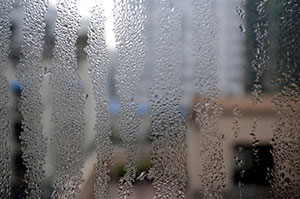Condensation & Humidity: How to Control it in your Building
- Clyde Anderson
- Aug, 16, 2018
- Efficient Design Elements
- Comments Off on Condensation & Humidity: How to Control it in your Building
 Condensation has been an issue in buildings for literally thousands of years. The cause is simple: warm, humid air comes into contact with a cold surface. If the cold surface is below the “dew point” of the humid air, condensation will form. It’s just like moisture forming on a mirror from a hot shower, really. Air always contains some amount of water – that’s what humidity is, after all – so it’s not a matter of “if” condensation will form, but “when” a surface becomes colder than the dew point so it will form. It’s unlikely likely but still not impossible for air below 0 °C to still contain moisture and still cause condensation issues!
Condensation has been an issue in buildings for literally thousands of years. The cause is simple: warm, humid air comes into contact with a cold surface. If the cold surface is below the “dew point” of the humid air, condensation will form. It’s just like moisture forming on a mirror from a hot shower, really. Air always contains some amount of water – that’s what humidity is, after all – so it’s not a matter of “if” condensation will form, but “when” a surface becomes colder than the dew point so it will form. It’s unlikely likely but still not impossible for air below 0 °C to still contain moisture and still cause condensation issues!
The damage condensation can cause goes beyond just making a surface feel unpleasantly damp. Moisture in an unwanted space may cause rust or rot to the building materials, or encourage the growth of mould & other related allergic or respiratory issues. Also, apart from a minority of extreme climates within Australia that are always too cold or too hot, condensation can come from both directions – both outside and inside, so to speak. Because you can’t control the weather to eliminate it completely, the next best option is to understand the risk and effectively manage it. To properly manage it though, you need to keep in mind that if a building’s surface isn’t “airtight”, moisture will travel with the air through not just any gap or hairline crack but also any permeable surface. And just to give you an idea of how this can happen in unexpected ways, standard indoor plasterboard & normal interior paint are both permeable – that is, water vapour will slowly pass through both of them!
The most damaging form of condensation is unseen or “interstitial condensation”. This is found between building surfaces, inside walls & within roof spaces – places not designed to become damp. Unnoticed & untreated, moisture may start to build up, eventually causing extensive damage to the building’s internal structure requiring costly repairs.
How can you Prevent or Manage Condensation?
There’s three main ways to manage moisture & prevent damage inside a building:
- Separation – Keep the humid air away from cold surfaces with an air-tight barrier, or try to separate any obvious water vapour from vulnerable, porous surfaces.
- Warming – Increase the cold surface temperature to above the dew point. This can usually be done with insulation or by controlling heat transfer through the building.
- Drying – Use extractor fans to increase ventilation to the area to help evaporate any moisture. This can sometimes be done through purely passive means, but fans will deliver more airflow (more than even an open window can).
Can an Air-Tight Building Prevent Condensation?
- Will improved sealing reduce condensation?
Adding a layer of Separation can help, because less air will be passing through the building’s surfaces. However, if moisture permeates the structure through any other means it won’t completely eliminate it, because improved sealing doesn’t help with warming or drying. - Can sealing the building on the inside reduce humid air entering the walls or roof-space from outside?
In short, no. Bathrooms are normally sealed on the inside better than usual as they’re a special high-humidity case, but even this isn’t normally perfect. A well-sealed building envelope will minimise humid inside air entering the walls and ceiling through infiltration, but is not likely to reduce humid air permeation, from outside or inside. - Can a building that has fewer & smaller air gaps reduce the permeability of water vapour through building surfaces?
A “tighter” building won’t reduce the likelihood of condensation from humid outside air or by permeation from humid inside air if the building materials themselves are still permeable, so it depends on what building materials are used. In fact, sometimes this can offer reduced drying from reduced airflow between building surfaces, which can actually make things worse.
Can Improved Building Energy Efficiency Reduce Condensation Risk?
It all depends on the materials the building is made from plus how the building is designed & constructed. Things like increased insulation can definitely help with warming, but using the wrong products (or even the right products installed the wrong way) can end up making things worse. At the end of the day though, many of the techniques designed to combat condensation can also be used to increase the building’s energy efficiency, so it’s all up to how well the building is designed. For more information on this topic, we recommend the Australian Building Codes Board’s handbook Condensation in Buildings for more information.
If you’d like more information about how to improve the energy efficiency of your building, contact us for a free fee proposal!
